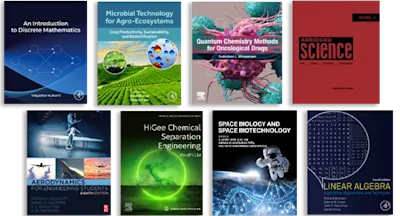
Chemosensor Arrays
Fundamental Pattern Recognition, Development and Applications
- 1st Edition - May 1, 2026
- Latest edition
- Authors: Tsuyoshi Minami, Tetsuya Kobayashi, Yui Sasaki
- Language: English
- Paperback ISBN:9 7 8 - 0 - 3 2 3 - 9 0 8 6 7 - 2
- eBook ISBN:9 7 8 - 0 - 3 2 3 - 9 0 8 6 8 - 9
As demand has increased for innovative methods in simple everyday monitoring, chemists are focusing on chemical sensors based on molecular recognition chemistry. Conventional… Read more
Purchase options

As demand has increased for innovative methods in simple everyday monitoring, chemists are focusing on chemical sensors based on molecular recognition chemistry. Conventional approaches involved the development of selective chemical sensors to specifically detect species of interest, whilst more recent studies have revealed the potential of cross-reactive molecular recognition. Such approaches, combined with pattern recognition, are a powerful technique to gain much qualitative and quantitative information. However, pattern recognition is frequently misunderstood and misinterpreted, leading to inaccurate interpretation of results. Chemosensor Arrays: Fundamental Pattern Recognition, Development and Applications aims to help researchers in the design and application of chemosensor arrays, and the accurate interpretation of data patterns in molecular recognition chemistry. Beginning with an introduction to chemosensing, the principles of chemosensors, and the fundamentals of computational principles and methods for chemical sensing, the book goes on to explore some key design strategies and examples with chapters on a biological nose, artificial nose and artificial tongue. Applications to real world scenarios are then discussed, followed by consideration of future needs and developments in the field. Based on the cross-disciplinary experience of its expert authors, Chemosensor Arrays: Fundamental Pattern Recognition, Development and Applications provides practical advice for all those interested in pattern recognition-driven chemical sensing.
- Outlines the chemical knowledge needed to support rational molecular design of chemosensors for pattern recognition
- Discusses successful data pre-processing and accurate interpretation of results, highlighting the importance of avoiding misinterpretation or overinterpretation of results
- Provides guidance on array design with strategies for developing artificial tongues and noses for chemical sensing
Undergraduate and graduate students studying supramolecular chemistry, mathematical sciences, organic chemistry and analytical chemistry, Researchers in industry as a guide for pattern recognition, big-data analysis, and the Internet of Things (IoT), Mathematical scientists who are interested in the collaboration with chemical sensing
1. Introduction to Chemosensing
2. Introduction to Intermolecular Interactions
3. Principles of Chemosensors
4. Computational Principles & Methods for Chemical Sensing
5. Design Strategy for Artificial Chemosensor Array
6. Biological Nose For Chemical Sensing
7. Artificial Nose For Chemical Gas Sensing
8. Artificial tongue For Chemical Solution Sensing
9. Applications in Real Scenarios
10. Multivariate Analysis
11. Future Needs and Developments
2. Introduction to Intermolecular Interactions
3. Principles of Chemosensors
4. Computational Principles & Methods for Chemical Sensing
5. Design Strategy for Artificial Chemosensor Array
6. Biological Nose For Chemical Sensing
7. Artificial Nose For Chemical Gas Sensing
8. Artificial tongue For Chemical Solution Sensing
9. Applications in Real Scenarios
10. Multivariate Analysis
11. Future Needs and Developments
- Edition: 1
- Latest edition
- Published: May 1, 2026
- Language: English
YS
Yui Sasaki
Dr. Yui Sasaki received her Ph.D. degree from the University of Tokyo in 2020 under the supervision of Associate Professor Tsuyoshi Minami. Between 2018 and 2021, she was a JSPS Research Fellow for Young Scientists (DC1) and JSPS postdoctoral fellow (PD) at the University of Tokyo. Currently, she is a project researcher at the same university. During her Ph.D. course, she worked with Professor Yang Tian of East China Normal University (China) in 2019 and Professor Karsten Haupt of University of Technology of Compiègne (France) in 2020 on collaborative projects. Her research interests include molecular self-assembled systems.
Affiliations and expertise
Institute of Industrial Science, The University of Tokyo, Tokyo, Japan